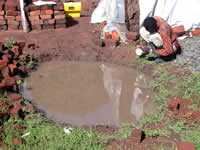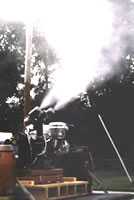Larval Control and Other Vector Control Interventions
Larval Control
Interventions targeting the larval stages of the mosquito are used in developing countries. While these interventions can be popular, the evidence for their effectiveness is generally weak and there is a critical need for more rigorous evaluation of the ecological settings in which they might have an impact on reducing malaria transmission.
Theoretically, larval control would seem to be an ideal approach to mosquito control as it eliminates mosquitoes before they reach the stage where they can transmit malaria. However, larval habitats may be small, widely dispersed, and transient.
Anopheles gambiae, one of the primary vectors of malaria in Africa, breeds in numerous small pools of water that form due to rainfall. The larvae develop within a few days, escaping their aquatic environment before it dries out. It is difficult, if not impossible, to predict when and where the breeding sites will form, and to find and treat them before the adults emerge. Therefore, larval mosquito control for the prevention of malaria in Africa has not been attempted on a large scale. It may, however, be appropriate for specific settings such as urban environments or desert fringe areas where habitats are more stable and predictable. WHO recently recommended larval control as appropriate for areas where the larval habitats are "few, fixed, and findable."

Source reduction: The burrow pit resulting from the activity of this brickmaker in Kisian (western Kenya) is a potential breeding site for Anopheles larvae. Filling the burrow pit would remove a source of Anopheles adults.
Larval control may be implemented through source reduction, chemical larviciding, and through biological control.
Source Reduction
Source reduction is removal or permanent destruction of mosquito breeding sites. The larval habitats may be destroyed by filling depressions that collect water, by draining swamps or by ditching marshy areas to remove standing water. Container-breeding mosquitoes are particularly susceptible to source reduction as people can remove or cover standing water in cans, cups, and rain barrels around houses. Mosquitoes that breed in irrigation water can be controlled through careful water management.
Chemical Larviciding
For some mosquito species, habitat elimination is not possible. For these species, chemical insecticides can be applied directly to the larval habitats. Other methods, which are less disruptive to the environment, are usually preferred:
- Oils may be applied to the water surface, suffocating the larvae and pupae. Most oils in use today are rapidly biodegraded.
- Toxins from the bacterium Bacillus thuringiensis var. israelensis (Bti) can be applied in the same way as chemical insecticides. They are very specific, affecting only mosquitoes, black flies, and midges.
- Insect growth regulators such as methroprene are specific to mosquitoes and can be applied in the same way as chemical insecticides.
Biological Control
Potential biological control agents, such as fungi (e.g., Laegenidium giganteum) or mermithid nematodes (e.g., Romanomermis culicivorax), parasitize and kill larval mosquitoes but they are not efficient for mosquito control and are not widely used. Likewise, mosquito fish (including Gambusia affinis) have largely been ineffective except in a few studies.
Other Vector Control Interventions

Fogging (area spraying) using a machine mounted on the back of a truck.
Fogging or Area Spraying
Fogging or area spraying is primarily reserved for emergency situations such as epidemics. Fogging has not been shown to be effective in any malaria-endemic areas. Fogging and area sprays must be properly timed to coincide with the time of peak adult mosquito activity, because resting mosquitoes are often found in areas that are difficult for the insecticide to reach (e.g., under leaves, in small crevices). In addition, fogging and area spraying will have to be repeatedly applied to have an impact, and it can easily become too costly to maintain or result in the overuse of insecticides.
Personal Protection Measures
Personal protection measures include the use of window screens, ITNs, and repellents (such as DEET) and wearing light-colored clothes, long pants, and long-sleeved shirts. Well-constructed houses with window screens are effective for preventing biting by mosquitoes that bite indoors and may have contributed to the elimination of malaria from the United States and Europe. Recent evidence suggests that repellents may be effective in reducing malaria transmission and may be appropriate for areas where mosquitoes bite outdoors or early in the evening when people are not using ITNs. However, while repellents are recommended for travelers to malaria-endemic areas, further work to develop repellent formulations that are easily deployed in endemic countries is needed.
Sterile Male Release
Introducing sterile male mosuitoes into an area has been successfully applied in several small-scale areas. However, the need for large numbers of mosquitoes for release makes this approach impractical for most areas.
Genetic Modification of Malaria Vectors
Genetic modification aims to develop mosquitoes that are not susceptible to the parasite. This approach is still many years from application in field settings.
Get email updates about Malaria
To receive email updates about this page, enter your email address:
Contact Us:
- Centers for Disease Control and Prevention
1600 Clifton Rd
MS A-06
Atlanta, GA 30333 - Health care providers needing assistance with diagnosis or management of suspected cases of malaria should call the CDC Malaria Hotline:
770-488-7788 or 855-856-4713 toll-free
(M-F, 9am-5pm, eastern time). - Emergency consultation after hours, call:
770-488-7100
and request to speak with a CDC Malaria Branch clinician. - malaria@cdc.gov
 ShareCompartir
ShareCompartir


